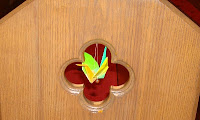...as we were recently...

Warmer temperatures are finally here for the weekend, but the sort of weather we associate with springtime in Nebraska has been slow in coming. In central Nebraska earlier this week, we were coping with a combination of rain (some of it freezing), sleet, and snow. Most of us were wishing the ice would simply go away!
Springtime is beginning in the Arctic as well. According to the University of Colorado-Boulder’s National Snow and Ice Data Center (NSIDC) , the Arctic sea ice probably reached its greatest extent for this year on March 7. Before the melting began, the maximum extent of this year’s Arctic sea ice was tied for the smallest extent of ice since record-keeping began in 1979. The final analysis of the 2010-2011 winter season for Arctic sea ice will be published later this month.
This year’s maximum sea ice extent was 463,000 square miles below the 1979-2000 average. The UPI story Study: 2011 arctic ice extent is down quotes a CU-Boulder release that gives a useful picture of how big an area this is: an area slightly larger than the states of California and Texas combined.
The extent of ice coverage at the end of the summer will be watched closely. This video from the NSIDC shows the changes in Arctic sea ice coverage in September for the thirty years between 1979 and 2009.
The effects of climate change on the Arctic are huge. A team of climatologists from the University of Nebraska–Lincoln and South Korea has predicted some of the impacts of climate change on the Arctic by 2099.
Many polar and subpolar regions may well be replaced by temperate regions by the end of this century. While the endangered polar bear has become the iconic representative of the expected changes, the effects of climate change on human economy, on local cultures, is of great concern. Plant and animal species and cultures are all in danger of extinction. That scientists from Nebraska and Colorado are studying the Arctic ice suggests that what is happening there has some importance to us in Nebraska.
Knowing something about what is happening in the Arctic can make us wonder how to respond to something so big and far away. The most important response we can give as Christians is to pay attention to what is happening. While it is very important for us to exercise good stewardship of our resources so that we reduce our own contributions to the carbon emissions driving global warming, it is also important for us do something less concrete: to be prayerful witnesses to what is happening. To acknowledge it, to see it, to be truth-tellers is part of our work as Christians. To remember it when we pray, when we make decisions about our own use of resources, and when we speak with other people and participate in the political process are all ways to serve as Christ’s body in the world.


